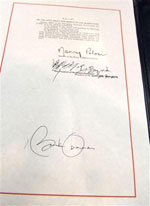Collecting Presidents
Sign Here. And Here. And Here.
For autograph and pen collectors this President is good news.
In Washington, the cherry trees are blooming, and that’s not all. Now is the U.S. printing office’s busiest season. The flurry of government documents began with publication of the 759-page House Resolution No. 1, the stimulus bill. Some Congressmen complained they didn’t get a chance to read it before it reached the President. The President responded in kind with a budget plan, but at 140 pages it was merely an outline.
Many more pages will be generated this spring and summer, as Congress responds to the President by drafting appropriations bills or passing resolutions to continue government operations. Last November’s resolution ran to 1,123 pages. Congressmen complained about not being able to read that, either. How can this most literary of Presidents sign bills neither he nor anyone else has read?
Yet sign he must. For the budget plan, President Obama used 11 pens, one for each letter of his first and last name, “Barack Obama.” He gave each pen to a staffer who helped write the plan. When bigger documents come to his desk—like a plan to save the banks not saved by previous plans—there will be more helpers, most of them Congressmen, and so the President may sign “Barack Hussein Obama,” which would yield 18 souvenir pens. For autograph and pen collectors this President is good news.
Back in the days of FDR and earlier Presidents, budget documents were short—the Social Security Act was 45 pages—and so was the ceremony of signing. To legalize Social Security, FDR used a single pen, which he gave to the Fraternal Order of the Eagles, an unlikely and thus welcome supporter of the measure. The Homestead Act, signed by Lincoln in 1862, was three pages, and Lincoln kept the pen he used. A steel tip, it survived to be auctioned in recent years. None of the quill pens used to sign the Declaration of Independence or the Constitution proved so sturdy. Then again, these are one- or two-page documents, and none of the signers is likely to have used a different pen for each letter. Obviously John Hancock didn’t—his familiar signature is all of a piece; and as for George Washington, on the constitution and elsewhere he routinely abbreviated his first name.
Collecting isn’t what it was. Once less was more. Now more will be less.









